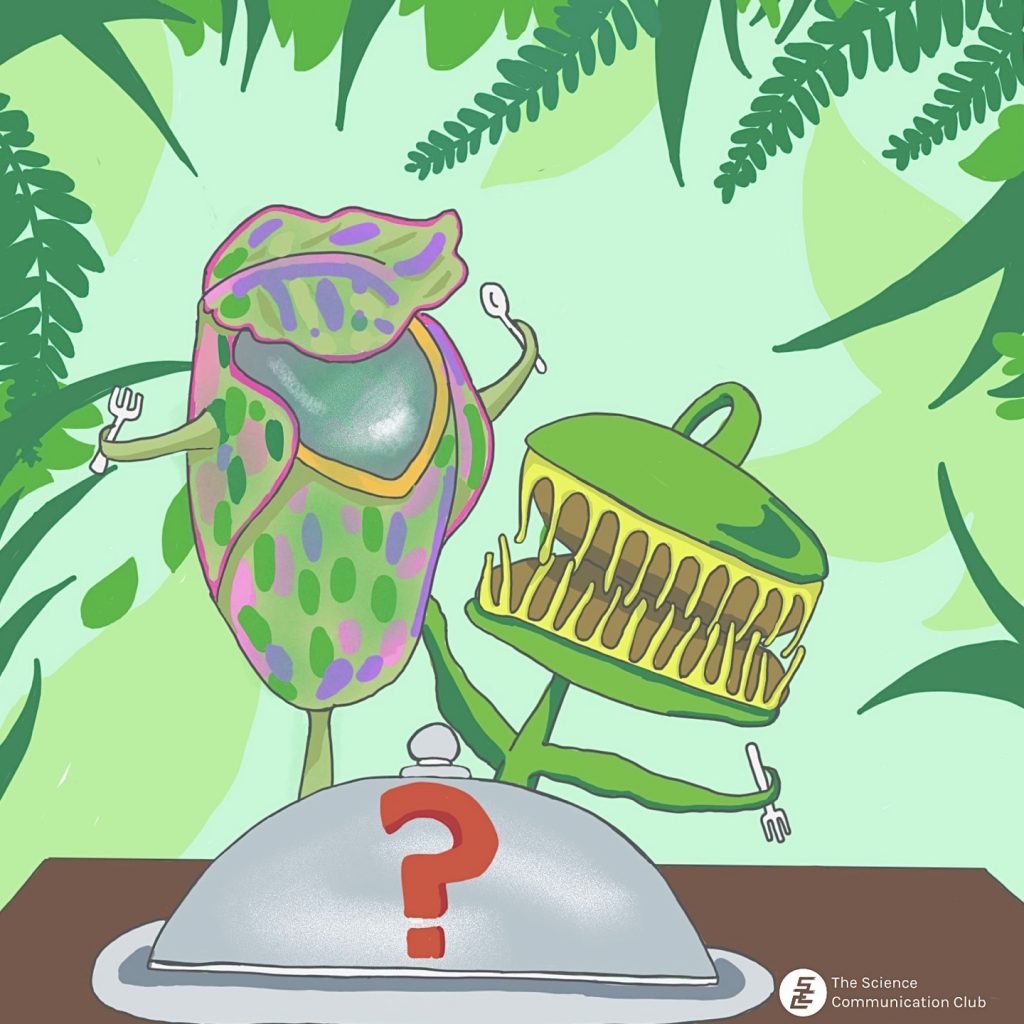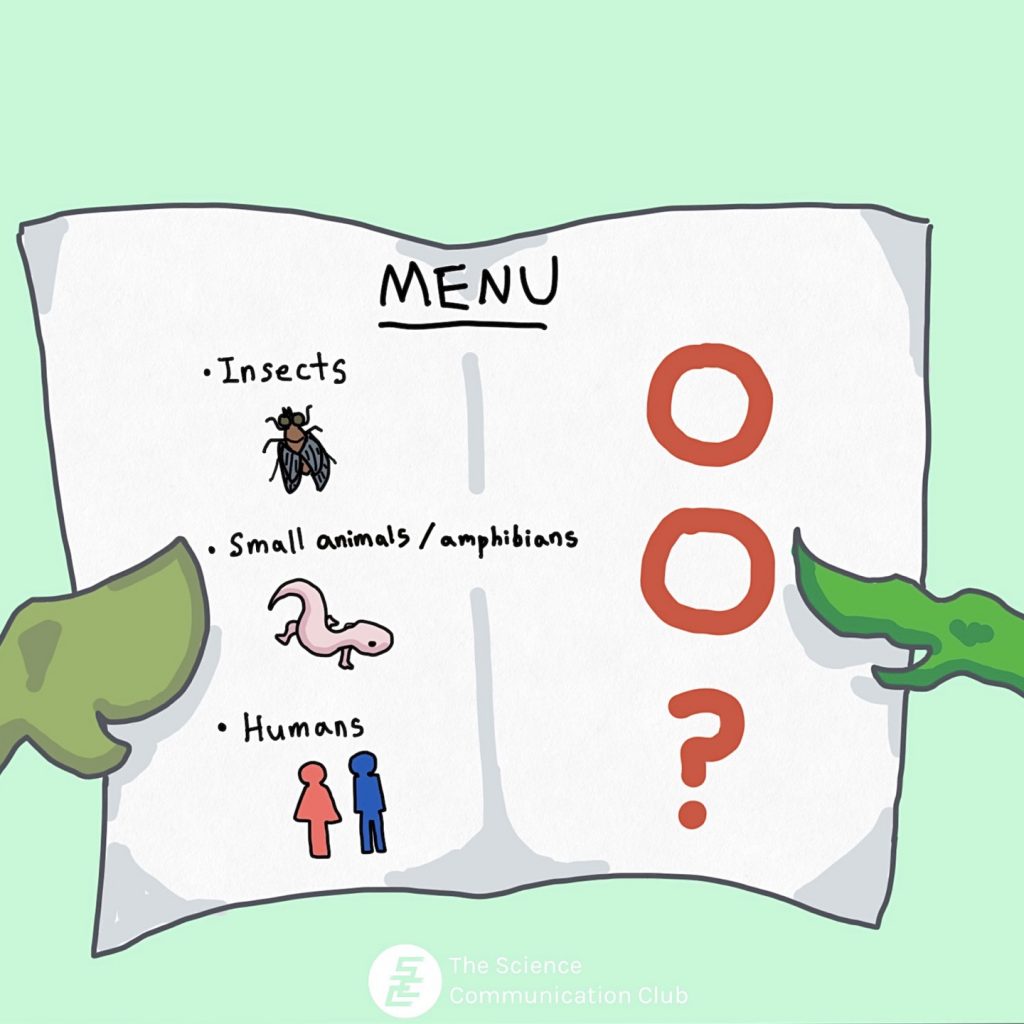
Written by Angie Lo
Illustrated by Haely Oh
This article is part of our Special’s Week series, The Science of Science Fiction and Popular Media.
When Charles Darwin published his book Insectivorous Plants in the late 19th century, the idea of meat-eating flora larger than life soon captured the imaginations of creators. Plants capable of devouring human beings became a regular subject of periodical pieces, and featured in stories by famous authors Sir Arthur Conan Doyle and H.G. Wells1. The idea of the man-eating plant has continued to endure in fiction—perhaps most famously in the musical film Little Shop of Horrors, where a sentient plant introduced into a flower shop demands the blood of its owner and soon begins to devour those around him.
While the carnivorous plants of our world don’t get as horrifying as those in science fiction, they’re nevertheless capable of some pretty gruesome feats. And there have been some unexpected discoveries about these plants which challenge the ways we think about their carnivory. But how carnivorous does a carnivorous plant actually get? And is it possible that it could eat away at our flesh?
How do plants become carnivorous, anyway?
Carnivorous plants grow in environments which are poor in nutrients, meaning they need to turn to an alternative source of nourishment—usually in the form of unsuspecting insects2. These plants have built-in traps which help them capture their prey. The most familiar is the snap trap: used by plants such as the iconic Venus flytrap, the trap is activated when insects landing inside the plant stimulate trigger hairs on the inner surface, leading to an electrical impulse that snaps it shut2.
But these plants also have a variety of other ways to capture their meals. One example is the pitfall trap. Some plants, such as the pitcher plant, have a leaf or rosettes forming a cup-like structure. These plants have insect-attracting nectar on the rim of their “cup”, but critters beware: the rim also contains a slippery substance that causes prey to fall into the cup, which contains deadly digestive fluid (more on that later)2. Yet another example is the adhesive trap, which is used by plants with sticky droplets mistaken by prey for nectar or dewdrops. But once prey make contact with these droplets, they’re unable to pull themselves away2.
Once the prey is safely stuck inside (or to) the plant, the digestion process can begin. Some of these plants harbour bacteria which break down their prey for them2, but most plants do it themselves by secreting enzymes and other digestive compounds3. The compounds are secreted by cells called glands, located on the epidermis (outer surface) of the plants’ leaves. These special cells have an all-in-one function: they also absorb nutrients from the prey once it gets broken down3.
Digestion in carnivorous plants has parallels to that in animals: both secrete a rich variety of digestive enzymes and have highly acidic digestive fluids3. Carnivorous plants even secrete enzymes similar to pepsin, a major digestive enzyme in the human stomach3. So the next time you chow down breakfast, consider that your tummy might have more in common with a Venus flytrap than you think.
Beyond insects: the other things found inside carnivorous plants
Carnivorous plants mainly feast on insects, and some also eat comparably small or smaller creatures2. But in a way that seems to echo the stuff of science fiction, larger plants have been found to also digest much bigger things, like reptiles and small mammals2. For instance, Nepenthes rajah—a type of pitcher plant with a cup large enough to hold over three litres of liquid—can trap lizards and small rodents inside its giant cavity4.
However, these creatures weren’t considered part of these plants’ regular diets, instead thought to be trapped occasionally and by accident5. But a surprising finding by a pair of Canadian scientists challenged all that. While doing a study on Sarracenia purpurea (aka the northern pitcher plant) in the field, they spotted tiny salamanders trapped inside the plants6. After making further observations over time, they agreed that salamanders were captured by plants with “high frequency”6:at one point, salamanders were present in almost 20% of the plants surveyed. Some of the plants even had more than one salamander inside—all in all, greater than what you’d expect from an occasional prey.
The findings suggest these salamander meals might be an important seasonal prey source for the plants6. The study has sparked more research questions for the scientists going forward, including whether the northern pitcher plant also feasts frequently on other vertebrates5. If they do, then these plants come surprisingly close to having an appetite worthy of a sci-fi novel.

Could a carnivorous plant digest human flesh?
Despite the surprisingly large creatures found within flesh-eating plants, there exist none big enough to trap something the size of a human. But what about their digestive capabilities? Are the enzymes secreted by these plants strong enough to break down our flesh?
The answer can be speculated based on things we already know—conservation ecologist Hali’a Eastburn states that since carnivorous plants can digest small mammals, they likely can digest small pieces of human flesh, too7. And some curious enthusiasts have even found ways to actually test the question out first-hand.
James J. Orgill, who runs the popular science YouTube channel The Action Lab, was inspired by Little Shop of Horrors to put the man-eating potential of Venus flytraps to the test8. He ran an amateur experiment which involved taping his middle finger to the inside of a Venus flytrap, then observing the results when six hours had passed. After a long time of very awkward waiting (including having to go to the toilet while stuck to the flytrap), Orgill found that his finger had a spot that was blue and swollen “like the start of a blister”8, suggesting that the plant’s enzymes had some damaging effect on it.
Botanist Barry Rice also performed a gross but extremely interesting amateur experiment on the topic9. After recovering from a case of athlete’s foot, he fed four of his Venus flytraps chunks of dead skin which had peeled off his feet (Ick!) After a week, he saw that in all four flytraps, most of the skin had been digested away—and the remaining bits of skin had a slimy consistency resembling, in his words, “little boogers.”9 (Double ick!)
However, we can’t be fully sure of the accuracy of these results, as the tests haven’t been performed with the same rigour or precision of more thorough experiments. In order to draw stronger conclusions, we’d need more people testing the flesh-eating capabilities of numerous plants, and reviewers making sure the tests were being run properly (though I’m not sure we’d find many people who willing to try it.)
But though that question may never be fully investigated, we’ve still come a long way in learning about the inner workings of these meat-eating plants, and finding that the extent of their carnivory might just be greater than we think it is. They might not exactly be the stuff that sci-fi creators dreamed up—but they’ve still got plenty of scary and marvelous features that make them seem larger than life.
Sources
- X-Men: First Class Quotes. 2011 [accessed 2022 Nov 18]. https://www.imdb.com/title/tt1270798/quotes/qt1438391
- Bai N, Smith D. Scientists Discover How Gene Mutation Reduces the Need for Sleep. University of California San Francisco. 2018 Mar 16 [accessed 2022 Nov 18]. https://www.ucsf.edu/news/2018/03/410051/scientists-discover-how-gene-mutation-reduces-need-sleep
- Are You a Supertaster? healthline. 2019 Feb 21 [accessed 2022 Nov 18]. https://www.healthline.com/health/food-nutrition/supertaster
- “Unbreakable” bones prompt a hunt for genes. Yale Medicine Magazine. 2002 Autumn [accessed 2022 Nov 18]. https://medicine.yale.edu/news/yale-medicine-magazine/article/unbreakable-bones-prompt-a-hunt-for-genes/
- Osteoporosis. National Institute on Aging. [accessed 2022 Nov 18]. https://www.nia.nih.gov/health/osteoporosis
- New genetic variants associated with coffee drinking. Harvard T.H. Chan School of Public Health. 2014 Oct 7 [accessed 2022 Nov 18]. https://www.hsph.harvard.edu/news/press-releases/genetic-variants-linked-with-coffee-drinking/
Resource for the list of superpowers:
Pflanzer LR. 8 genetic mutations that can give you “superpowers.” INSIDER. 2016 Jan 9 [accessed 2022 Nov 18]. https://www.businessinsider.com/genetic-mutations-that-make-you-more-awesome-2016-1#actn3-and-the-super-sprinter-variant-1